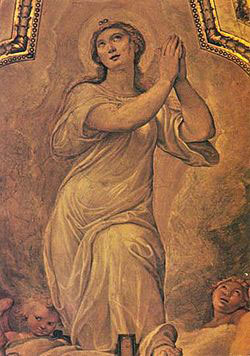
Feastday: August 11
Death: 3rd century
The beautiful daughter of Gabinius, a priest, and niece of Pope Caius, Susanna refused Emperor's Diocletian request that she marry his son-in-law, Maximian and converted two of her uncles, Claudius and Maximus who were court officers sent by Diocletian to persuade her to marry, to Christianity. Diocletian was so enraged by what she had done that he sent one of his favorites, Julian, to deal with the matter. Julian had Maximus, Claudius and his wife, Praepedigna, and their two sons, burned to death at Cumae, and then had Susanna and her father beheaded. There was a Susanna who lived in Rome, but the details of the story are fictitious. Her feast day is August 11th.
Susanna of Rome (fl. 3rd century) was a Christian martyr of the Diocletianic persecution. Her existing hagiography, written between about 450 and 500, is of no historical value and the relations it attributes to Susanna are entirely fictitious. It is probable that a real martyr named Susanna lies behind the literary invention.
Her feast day is on 11 August in the Roman Martyrology, but since 1969 her veneration has been limited to the Church of Santa Susanna in Rome. She has no connection to Saint Tiburtius, who is commemorated on the same day. The Church of Santa Susanna was originally that of Gaius, but by 595 it was named after Susanna, possibly because of the popularity of her hagiography.
Legend
Saint Susanna, virgin and martyr, is said to have been the daughter of Saint Gabinus of Rome. The lengthy account given of her in mediaeval legend is very unreliable. It appears that on her refusal to marry a pagan relative of the Emperor Diocletian, she was arrested as a Christian. According to her Acts, she was beheaded about the year 295, at the command of Diocletian, in her father's house, which was turned into a church, together with the adjoining one belonging to her uncle, the prefect Caius or, according to other accounts, Pope Caius. The church became known as Sancta Susanna ad duas domos.
Susanna is mentioned in the Roman Martyrology for 11 August in the following terms: "At Rome, commemoration of Saint Susanna, in whose name, which was mentioned among the martyrs in ancient lists, the basilica of the titular church of Gaius at the Baths of Diocletian was dedicated to God in the sixth century." The commemoration of her that was included in the General Roman Calendar was removed in 1969 because of the legendary character of the Acts of her martyrdom.





